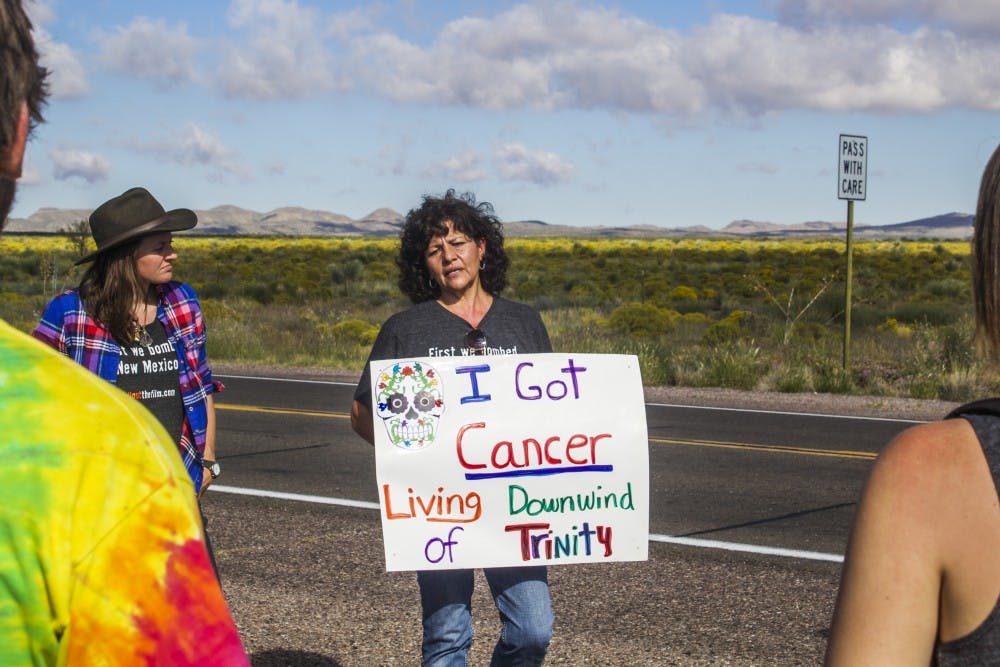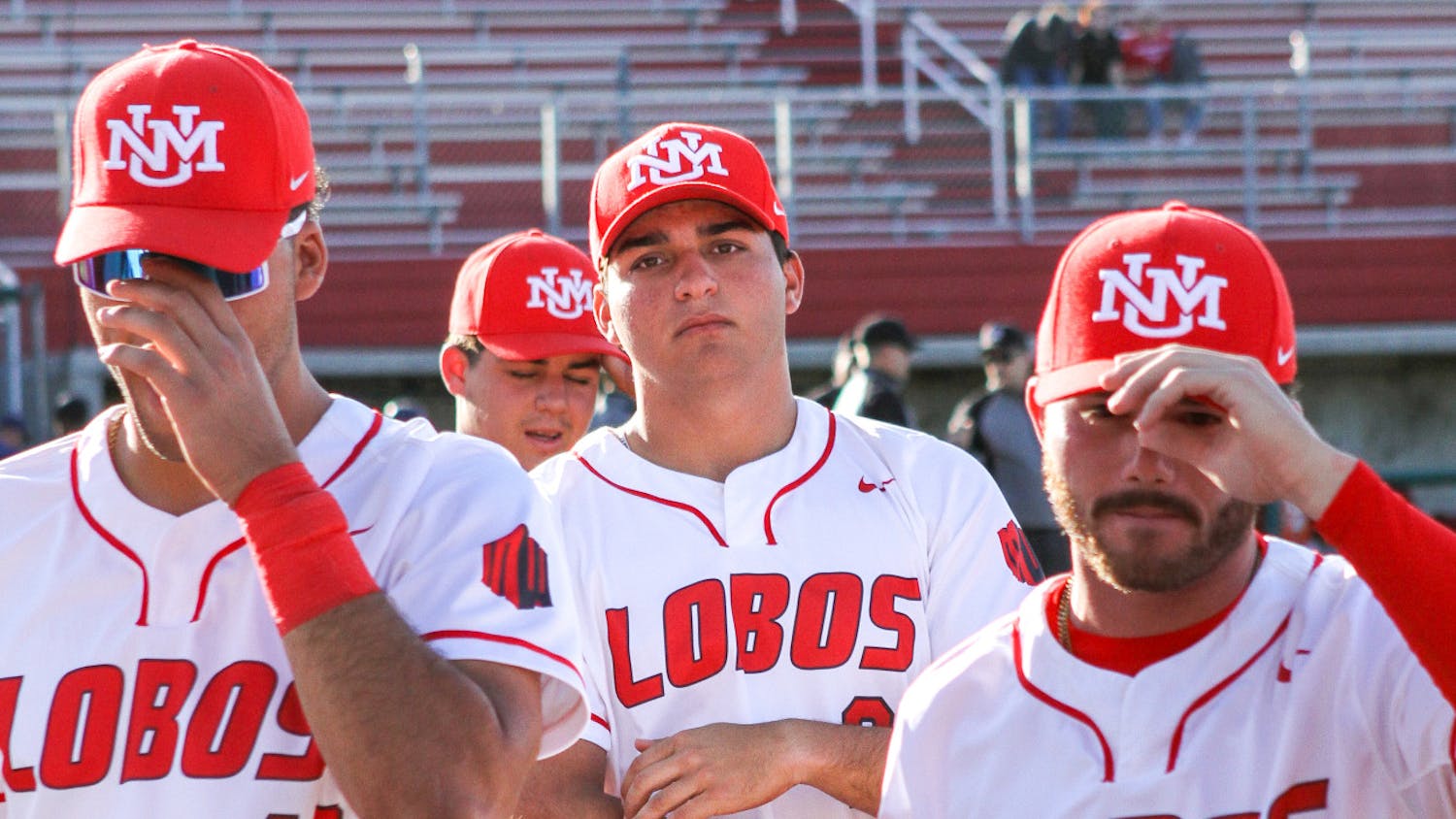New Mexico protesters assembled at Trinity Site on Saturday to demand reparations for health issues caused by U.S. nuclear testing.
The Trinity Site, located in the Tularosa Basin, is home to the first detonation of a nuclear weapon in history. The site only opens twice a year and welcomes hundreds of tourists from across the world looking to enrich their understanding of U.S. atomic history.
Tina Cordova, along with Fred Tyler, started the Tularosa Basin Downwinders Consortium in 2005, a group dedicated to proving their mistreatment as U.S. citizens through medical research, peaceful protest and legal representation in court.
Cordova, emphasized that she is not a nuclear tourist, but a nuclear survivor.
Cordova grew up ‘downwind’ of the Trinity site in Tularosa, New Mexico and as a result, has battled thyroid cancer for over 16 years, while watching numerous family members suffer and succumb to various cancers.
The 1945 detonation of the atomic bomb created nuclear fallout which had devastating medical effects on people inhabiting the area surrounding the Trinity Site.
At the time of the test, the U.S. government proclaimed that the area around Trinity was primarily “uninhabited.” However, a 1941 census revealed that there were 40,000 people living within a 40-mile radius of the explosion, Cordova said.
Tularosa downwinder Genoveva Peralta Purcella was born one year after the nuclear test, but compiled an account of her family’s experience during the test on July 16, 1945.
“When the explosion happened the sky turned dark and the ground shook,” Purcella said. “After the initial shock (my dad) immediately ran inside to see if everyone was safe. He entered the house, dusting himself off as he walked inside. He was covered in a white powder.”
The white powder was radioactive material, or fallout, she said.
Out of 10 children in the Purcella family, seven of them were stricken with cancer, and four of them lost their lives.
Both of her parents had cancer as well, she said, adding that her father had four different types of cancer and died at age 43.
Get content from The Daily Lobo delivered to your inbox
Billions in reparation costs
Families in rural New Mexico ate, drank and bathed from resources taken from the radioactive landscape, Cordova said. While Tularosa homes collected rainwater in wells, the well became contaminated, unbeknownst to them.
Cows either turned completely white or white on one side, the side facing the blast. Her family eventually ate these cows, she said.
Radioactivity does not just affect those who were alive during exposure, but mutations are passed down through generations, Cordova said, and in Tularosa there has been an abnormal rate of miscarriages and children born with deformities.
Hermann Muller, an American Nobel Prize-winning geneticist, said he was suspicious early on regarding mutations being a hereditary problem.
In his 1949 article “The Malice of Radiation,” Muller explained the foundational effects of radiation and human mutations.
“It is also well established,” Muller wrote. “Despite some objections by non-geneticists, that the frequency of the mutations induced in the genes is exactly proportional to the total dose of radiation, no matter in how concentrated or dilute a form the dose was received. Thus there is no dose without at least some slight risk, commensurate with its size.”
Since 1990, the U.S. Radiation Exposure Compensation Act has compensated downwinders in Nevada, Utah and Colorado.
RECA compensated $50,000 to each citizen affected in those states and, in total, paid out over $2 billion, Cordova said.
An action report prepared by the TBDC stated, “New Mexico has never been included in this fund although the people of New Mexico were the first downwinders. The fund has paid out over $2 billion in claims thus far to the downwinders of the Nevada test site and more importantly has provided lifetime health care coverage with no copayments or deductibles to those affected.”
If RECA was extended to New Mexico downwinders, it would cost the government an extra $10 billion, Cordova said.
Since the 1940s, the federal government has never visited the town of Tularosa or Socorro and has been reluctant to acknowledge the effects of radioactivity on New Mexico residents, she said. This has created a distrust between downwinders and the government.
Even though all five New Mexico congressional delegates support RECA’s extension, Congress has yet to endorse the bill, Cordova said.
Cordova urged New Mexico residents to reach out to their local government officials and let them know that this issue is a concern.
“Through the development of nuclear weapons and the storage of nuclear waste we should all be concerned about this, because it can have an impact on our health,” she said. “At a time when there are even more discussions about the development of nuclear weapons and the modernization of our nuclear arsenal — when our government is considering putting trillions and trillions of dollars into that process, we all need to start thinking about what that means.”
While the protesting Tularosa downwinders are often accused of being unpatriotic or anti-nuclear, Cordova said it is really an issue of welfare and neglect.
At the time of the nuclear testing, most of the men in Tularosa were off fighting in WWII, she said.
“Those of us living in these communities that have suffered greatly after the test of Trinity have nothing else to give to this. That is true patriotism,” Cordova said. “We were civilians that were engaged in this process without any knowledge or consent. We were unknowing, unwilling, uncompensated innocent victims of the first atomic bomb that was detonated anyplace in the world.”
Learning from the past to move forward
This year, Eileen Shaughnessy, a master’s student and lecturer for the UNM American Studies Department, took her sustainability class, Nuclear New Mexico, to Trinity to educate about the historical landmark and the downwinders of the Tularosa Basin.
Alexander Stelly, a senior liberal arts major, visited the Trinity Site last weekend and said the protesters were peaceful and respectful, and they were not there to discourage people from entering the site, but instead to educate people about the issue at hand.
“What I got from their protest was that they were trying to spread the word of their plight and possibly get the word out about the test done in New Mexico and the damage caused to the residents and families in the local area, not to take away from a controversial American achievement,” Stelly said.
Moreover, he said, it is important that UNM students know about this issue.
“It's history; repeating the past is not how we move forward as members of the human race, (We need) to learn form the cause and effect brought upon by extreme situations,” Stelly said.
Jonathan Natvig is a news reporter for the Daily Lobo. He can be reached at news@dailylobo.com or on Twitter @Natvig99.






